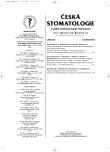Resonance Frequency Analysis of Dental Implants Placed Into the Sinus Lifts: at Stage1 and Stage 2 Surgery
Authors:
R. V. Somanathan 1; A. Šimůnek 1; J. Bukač 2; T. Brázda 1; D. Kopecká 1
Authors‘ workplace:
Department of Dentistry, Charles University in Prague, Faculty of
Medicine in Hradec Králové
Head of the department doc. MUDr. V. Hubková, CSc.
1; Department of Biophysics, Charles University in Prague, Faculty of
Medicine in Hradec Králové
Head of the department prof. MUDr. P. Stránský, CSc.
2
Published in:
Česká stomatologie / Praktické zubní lékařství, ročník 106, 2006, 4, s. 111-114
Overview
Measurement of primary stability of dental implants using resonance frequency analysis is found to be a reliable and evidence based method. It is believed that a higher value indicates a better stability and so a better prognosis for the implant. This kind of relation can also be expected from implants inserted in sinus lifts. This study proves that the values with a lower amplitude by time reach a higher value and those with higher initial resonance frequency value tend to decrease to somewhat lower values. That is, the secondary stability of the implant does not depend completely on primary stability value.
Key words:
sinus lift - resonance frequency analysis - ISQ values - implant stability
Labels
Maxillofacial surgery Orthodontics Dental medicineArticle was published in
Czech Dental Journal

2006 Issue 4
Most read in this issue
- Alternative Preparation Techniques in the Treatment of Dental Caries
- Adjustment of Physiognomy in Children with Down Syndrome
- Therapy of Recurrent Aphthous Ulcer by Removing of Electro-active Amalgam Fillings from the Oral Cavity
- Analysis of Dental Caries in 5-year Children
